Preparing first responders to battle propane fires, emergencies
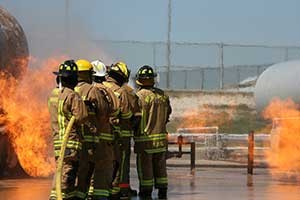
It’s best not to meet first responders for the first time during an emergency. Photo: Propane Council of Texas
Imagine waking up in the middle of the night to a call alerting you of a propane tank fire at a customer location and that your help is needed at the scene.
When you get to the customer’s house, a handful of first responders try to put out the flames. Local news media flock as close as they can to the fire to share the news. You push through the crowd to find the local fire chief to give your input on how best to approach the fire. When you get to the fire chief, will he actually listen to your advice?
When propane emergencies occur, having a relationship with firefighters, law enforcement and other first responders is critical.
“You don’t want to meet first responders for the first time at 2 a.m. during a fire,” says Carl Weeks, owner of Propane Training Services in Florida. “You need to establish a relationship with local fire departments. You don’t have to go bowling with them every Thursday, but you at least need to know each other.”
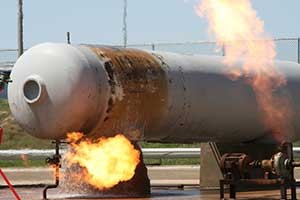
The Propane Council of Texas trains first responders from the Propane Emergencies program at the Brayton Training Field at Texas A&M University. Photo: Propane Council of Texas
It’s certainly not the retailers’ job to extinguish propane fires or pick up flipped bobtails, but they should be able to coach first responders through any propane emergency. Many first responder trainers in the propane industry agree that retailers need to establish a relationship with fire departments and law enforcement professionals. They say if those individuals don’t know you as a propane expert, they will likely just tell you to step away from the emergency.
For the past 15 years, the Propane Education & Research Council’s (PERC) Propane Emergencies program and similar state-sponsored industry responder conferences have helped propane retailers and first responders strengthen their relationships.
Mike Callan, one of three authors of the Propane Emergencies handbook, says training has expanded and become a norm in the industry since the program was implemented in the late 1990s. He estimates more than half of the states use the Propane Emergencies handbook model today to train first responders in their own community, and hundreds of thousands of first responders have been trained on the topic.
Wake-up call
Two volunteer firefighters died when a burning propane tank exploded in a boiling liquid expanding vapor explosion (BLEVE) on April 9, 1998, on a farm in Albert City, Iowa. Six other volunteer first responders were injured in the incident.
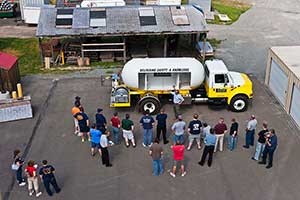
During sessions on how to handle propane emergencies, trainers will sometimes walk first responders through different parts of a bobtail. Photo: Propane Education & Research Council
Callan says this incident prompted the propane industry to focus more time and money on training first responders on how to approach propane-related fires and emergencies.
“The incident happened the same time PERC was forming and deciding how to help the industry,” Callan says. “When the Albert City incident happened, it catapulted us into creating Propane Emergencies and a general outline for training first responders.”
Stuart Flatow, vice president of safety and training for PERC, says the propane industry didn’t have a national effort or formal program to reach out and train first responders prior to the Albert City incident. He says any steps taken to educate first responders were likely part of a grassroots effort from individual propane retailers or state associations.
Callan was asked to help write the Propane Emergencies handbook in the late ’90s with Mike Hildebrand and Greg Noll. He was also asked to lead some of the program’s first training sessions across the United States.
According to Callan, the original intent of Propane Emergencies was to create a team of first responders serving as propane emergency experts who could train other first responders in their hometowns. He says these leaders would also be more proactive in seeking relationships with propane retailers.
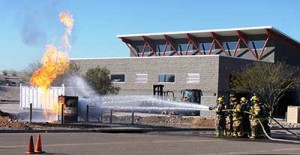
Live burns at industry training sessions give first responders experience in handling propane fires. Photo: Propane Education & Research Council
Dennis Cruise, Virginia Propane Gas Association outreach coordinator and a former first responder, says the training of first responders has advanced greatly since 1998. Cruise has been hosting first responder training sessions since 2007.
“From what I’ve seen, first responders tend to be more proactive now, visiting bulk plants and preplanning responses to propane fires,” Cruise says. “I’ve also heard a lot of requests to return to areas I’ve already seen and taught at.”
Lyndon Rickards, safety and training manager at Eastern Propane & Oil, agrees industry response training has improved. Rickards says the Propane Gas Association of New England has hosted training events with first responders since the early 1980s, but he says integrating information from the Propane Emergencies program and revising it over the years has made it better.
“I would say the program has evolved,” Rickards says. “Characteristics of propane don’t evolve, but making sure the first responders and all propane retailers are on an equal understanding of how to handle propane, along with new propane technologies, is important.”
Putting training in states’ hands
PERC tries to sponsor about five Propane Emergencies sessions per year at various locations across the U.S.
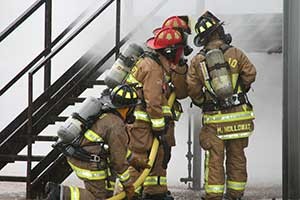
Propane Emergencies instructors through the Propane Council of Texas set up live burns for first responders at Brayton Training Field at Texas A&M University. Photo:
Flatow says each session costs $10,000 to $12,000 on average to host. Demand for Propane Emergencies sessions through PERC has increased, as well. Although PERC can commit to sponsor a handful of these events every year, Flatow says the council realized about five years ago it could meet the demand better by partnering with state associations to host Propane Emergencies.
“It was one of those things where I woke up one night and thought, ‘Why not partner with state associations on this?’” Flatow explains. “PERC can sponsor and fund the conferences, with the states hosting. The states have the local contacts with those we want to [attend] these conferences.”
Today, many state associations use PERC funds to host industry responder conferences. Cruise says some of these funds go toward setting up the event and paying for first responders to attend. On average, it costs each student $35 to attend Propane Emergencies or a similar first responder training session. Sometimes, this cost is out of a fire department’s budget, though.
“When you start looking into the numbers, an estimated 85 percent of the country’s firefighters are volunteers,” Cruise says. “Those guys don’t have the funds for elaborate training since they can barely afford basic safety equipment sometimes they need to do their jobs. So PERC likes to help fund for them to attend the training sessions.”
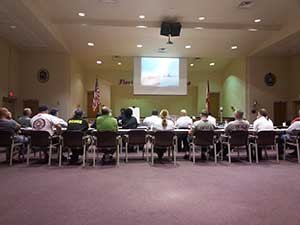
First responders watch videos at Propane Training Services’ training session. Photo: Propane Training Services
He adds that the investment makes sense because having first responders trained on propane means the country will have better-prepared first responders to serve.
“When the firefighters have better understanding of propane, it removes some of the fear that is created by lack of understanding,” Cruise says. “And having the propane retailer come to these events means they gain respect among first responders. This is a win-win scenario.”
In the classroom
When first responders approach a propane fire for the first time, many approach it with hesitancy. To those who are unfamiliar with propane, a storage tank fire or bobtail rollover might be overwhelming at first sight.
Richard Gilbert, an instructor of industry responder conferences, says this is a normal reaction of many first responders who have never tackled a propane fire.
“It’s like anything else,” he says. “If you’re not familiar with a product, such as propane, your imagination tends to get carried away with it.”
Being an industry responder conference trainer is something that comes naturally to Gilbert, who worked in the propane industry and as a first responder. Gilbert teaches the Propane Emergencies curriculum at Brayton Training Field at Texas A&M University in College Station, Texas. This particular training site is sometimes dubbed the “Disneyland for fire training” because of its dozens of props on which to practice.
Gilbert hosts a 16-hour, two-day course that combines two half-day classroom education sessions with two half-day hands-on experience sessions. A propane emergency should be manageable for any first responder having gained classroom experience, Gilbert says, as long as first responders realize they have the knowledge to control the situation.
“I explain different situations, signs of how or when they can control a situation,” he says. “With that, you instill confidence in the responders. It’s the unknown that makes them do strange things. But if we familiarize them with propane, it makes a difference when they get a call about it.”
During the hands-on session, instructors set up a live fire on propane equipment for first responders to test their classroom knowledge. First responders can put out fires on bobtails, residential tanks, propane grills and a transport.
“It’s nice because we can show them how all these things operate so the first responder can visualize it,” Gilbert says. “Not all trainers have this luxury.”
Weeks, with Propane Training Services in Venice, Fla., says his industry responder training cannot include live burns. Weeks manages Propane Training Services alone, explaining it would be too difficult for him to get liability insurance to host live burns in his classes. Because of that limitation, he shows his students videos on how to handle propane fires in all of his classes. He also reaches out to propane retailers near the class to bring in bobtails and related propane equipment.
Firefighters all agree that any additional, specified training they receive boosts their confidence. Todd Dorris, operations manager of Roadrunner Energy and a volunteer firefighter in Ubalde, Texas, attends the Propane Emergencies first responder event at Brayton Training Field regularly. As a part-time volunteer firefighter, Dorris says comfort levels increase with any additional fire safety training.
“To be more comfortable as a responder means you are comfortable that you can handle an emergency,” he says. “I love seeing first responders come back to their department and being confident enough to train others on propane emergencies, which makes everyone real aware.”
Industry responder conferences can also benefit the propane retailer attending. Rickards of Eastern says most of New England’s industry responder conferences are attended by an equal number of propane retailers and firefighters, explaining the association has been proactive in encouraging both groups to attend.
“After these events, we have first responders calling the propane marketer,” Rickards says. “Having them together in training makes a huge difference in the level of comfort of the fire service individuals. Having the groups together improves communication efforts.”
Propane retailers can learn how to mitigate potential incidents by attending these events, as well, Dorris adds. He says it is vital for propane retailers who have little knowledge about first responders to attend these events and connect with them.
“I think it’s especially critical to connect at these events,” he says. “Just think, if there is a major incident with one of your company’s tanks and the media gets involved, you could make things look really bad when you don’t have a relationship with the local firefighters.”
Future of Propane Emergencies
Propane characteristics don’t change, but technology in the propane industry constantly evolves.
Flatow says the Propane Emergencies handbook and training curriculum has been updated three times to keep up-to-date on equipment technology changes. He says it’s also been digitalized so that it can be viewed on smartphones or iPads.
Callan adds that he makes sure to include new, relevant scenarios in his training and in the handbook.
“For instance, today you might hear some stories of propane cylinders being stolen to store ammonia in them for meth labs,” he says. “That’s something a first responder might have to deal with, and that’s not something we mentioned in earlier editions of Propane Emergencies.”
The training programs are also a gateway for the retailer to build relationships with local firefighters – to say hello, create a pre-plan for certain emergencies, plan a visit to the fire department or the retailer’s plant. It will be appreciated.
Cruise says he can’t count the number of thank-you notes he’s received since becoming a first responder trainer.
“It never fails,” he says. “I get firemen of all experience levels come up to shake my hand and sincerely thank me. It’s almost guaranteed at the end of any training session we get a thank you for coming out. It’s just very, very rewarding.”
National Fire Protection Association annual averages from 2007 to 2011
■ 13,340 propane fires
■ 7,620 propane-related home fires
■ 5,720 propane-related non-home fires
■ 46 propane fire deaths
■ 349 propane fire injuries
■ $100 million in propane fire damages
Did you know: NFPA reports that about 35 percent of home fires are started by some kind of propane leak.
Megan Wilkinson is associate editor of LP Gas magazine. You can reach her at 216-363-7930 or mwilkinson@northcoastmedia.net.
















